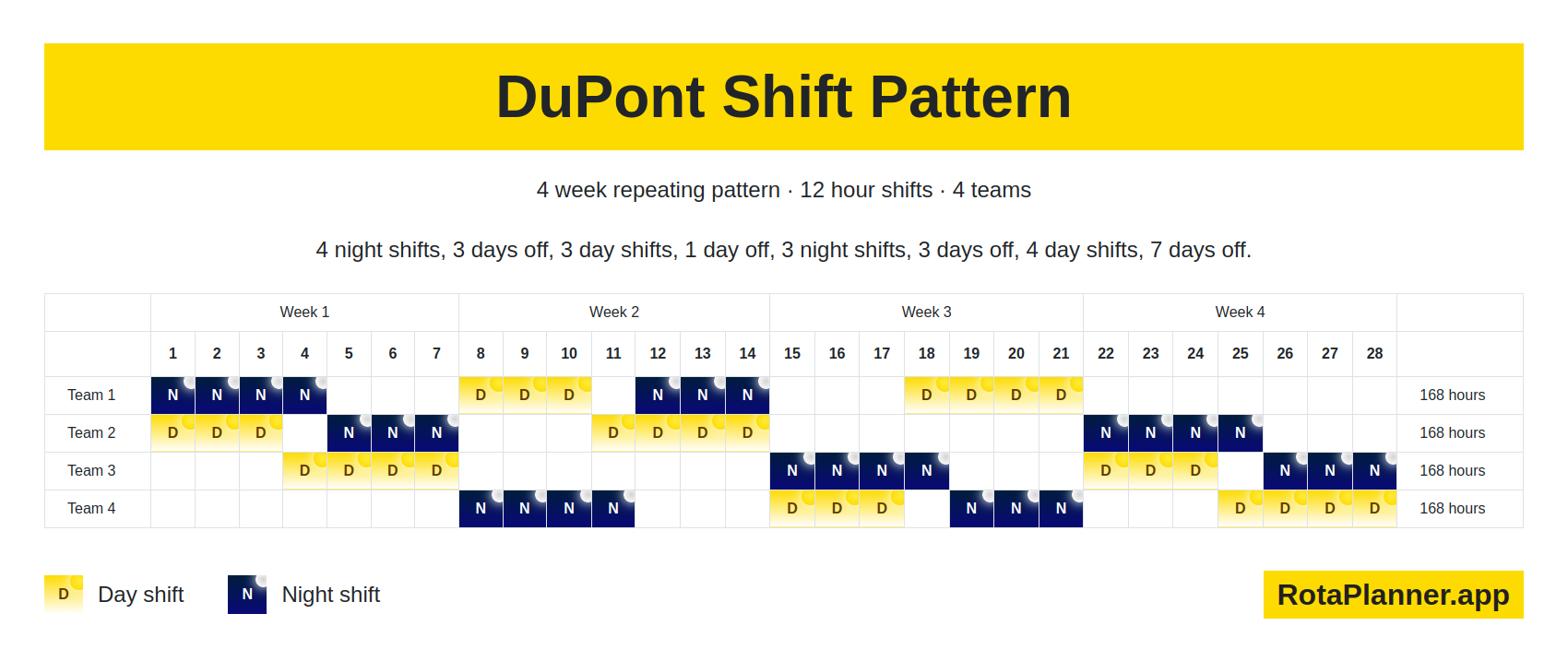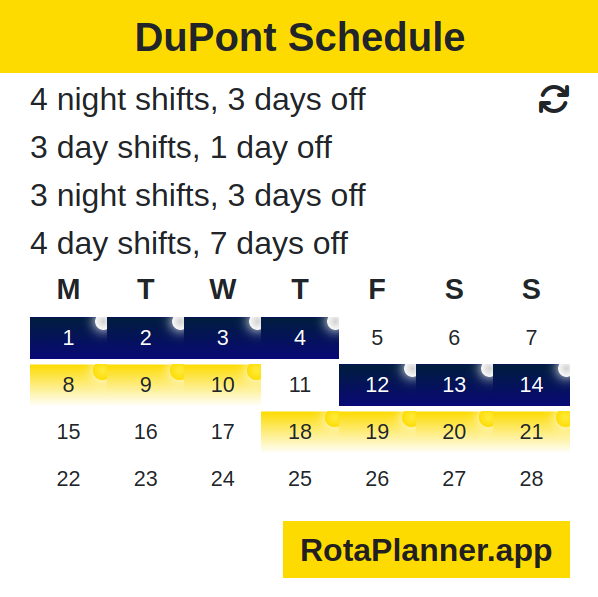
What is the DuPont Shift Pattern
The DuPont shift schedule is a 12-hour rotating shift pattern commonly used in industrial settings. Workers are divided into four crews that each work a specific shift schedule that rotates every 4 weeks.
The breakdown:
- 12-hour shifts (day shift and night shift)
- 4 crews that cover alternating shifts
- Rotating 4-week schedule where each crew works:
- 4 night shifts, 3 days off
- 3 day shifts, 1 day off
- 3 night shifts, 3 days off
- 4 day shifts, 7 days off

Also known as
Since the DuPont company pioneered the rotating 12-hour shift model in the early 1900s, the schedule is commonly referred to by several other names as well:
- Dupont Shift
- Dupont Schedule
- Dupont System
Hours & Pay calculator 💵
Use this calculator to see how much you should be paid, how much you should expect to earn and the hours you will work.
Assuming the most common 12 hour shifts, you will always work 168 hours every 4 weeks. Which is an average of 42 hours per week.
Options
Results
| Day hours | Night hours | Pay | |
|---|---|---|---|
| Per week | 21 | 21 | $630 |
| Per month | 90 | 90 | $2,700 |
| Per year | 1,095 | 1,095 | $32,850 |
These are averages and not exact values. The exact values depend on where in the shift pattern you start your calculations from and how long that specific month is.
Our rota software can do these calculations for you, and more.
Workings
With the DuPont shift pattern you will be working on average:
- 3.5 shifts per week
- 15 shifts per month
- 182.5 shifts per year
Here's a 4 weeks of the 'DuPont' shift pattern illustrated.
It contains 7 day shifts,
and 7 night shifts.
D = Day shift, N = Night shift, O = Off.
NNNNOOODDDONNNOOODDDDOOOOOOO
Year
And here is a full year illustrated, it has 91 day shifts, and 92 night shifts.
NNNNOOODDDONNNOOODDDDOOOOOOONNNNOOODDDONNNOOODDDDOOOOOOONNNNOOODDDONNNOOODDDDOOOOOOONNNNOOODDDONNNOOODDDDOOOOOOONNNNOOODDDONNNOOODDDDOOOOOOONNNNOOODDDONNNOOODDDDOOOOOOONNNNOOODDDONNNOOODDDDOOOOOOONNNNOOODDDONNNOOODDDDOOOOOOONNNNOOODDDONNNOOODDDDOOOOOOONNNNOOODDDONNNOOODDDDOOOOOOONNNNOOODDDONNNOOODDDDOOOOOOONNNNOOODDDONNNOOODDDDOOOOOOONNNNOOODDDONNNOOODDDDOOOOOOON
DuPont pros & cons
When considering whether to implement the DuPont shift schedule, companies must weigh the potential benefits and downsides. The rotating 12-hour shifts help reduce fatigue and improve work-life balance, but also require coordination and discipline. Understanding the key pros and cons can inform the decision to transition to this model.
Pros 👍
- Reduces fatigue by rotating shifts - avoids long stretches of overnight work
- Longer breaks between rotations allows for recovery from shift work
- Provides a better balance between work and personal life
- Shown to improve alertness during shifts
- Can lead to higher employee satisfaction and retention
Cons 👎
- Schedule requires careful coordination for shift coverage
- Workers need to adjust sleeping schedules when rotating
- Potential for reduced continuity on projects between shifts
- May be complex for payroll/tracking with multiple shift premiums
- Doesn't eliminate fatigue/safety issues fully for overnight shifts
Overall the consensus is the pros tend to outweigh the cons for most industries. The rotations provide a good balance between productivity and employee well-being. However, 12 hour shifts with manual labor can still be physically draining.
History
The DuPont shift schedule was developed in the early 1900s by the E. I. DuPont de Nemours company as a more humane solution to consistent night shift work in industrial plants.

At the time, many companies used consistent schedules where workers would stay on either day shifts or night shifts for extended periods of time. This was found to lead to issues with fatigue, health problems, safety issues, and personal/family life disruption especially for night workers.
In the early 1900s, DuPont began experimenting with different shift configurations to balance productivity to address these issues. They found the rotating 12-hour shift model helped increase alertness during shifts and allowed adequate breaks between rotations.
Key benefits they noted at the time were:
- Fewer fatigue-related safety issues
- Improved employee morale and engagement
- Better balance between work and personal lives
The company implemented this 12-hour shift model in most plants by the 1930s. The schedule then became more widely adopted by other manufacturing industries over next few decades as awareness of potential benefits increased.

Today, the DuPont model is still recognized as an innovative approach to shift scheduling to reduce safety issues and balance employee wellness needs.
Common Modifications to the DuPont Shift Schedule
While the core structure of the DuPont schedule provides a solid foundation, companies will frequently adapt aspects to better suit their needs.
Shift Length 🕒
- 8 or 10 hour shifts instead of standard 12 hours
- Adjustments to shift start/end times
Rotation Variations 🔄
- Flipping day and night sequences in the 4 weeks
- Changing number of days between rotations
- Modifying sequence of 3 nights vs 2 nights
Team Structures 👥
- More or fewer than 4 teams
- Unbalanced teams to match workload needs
Scheduled Overtime ⏰💼
- Planned OT factored into cycles
- Extra teams handle overtime needs
Experimentation allows companies to optimize the structure, shift lengths, and rotations to suit unique needs. The core ideas of frequent rotation, adequate breaks between shifts, and balance across teams remains central.
Add your comment
Comments
How do you mix the team every 6 months so the teams are not “married”?

